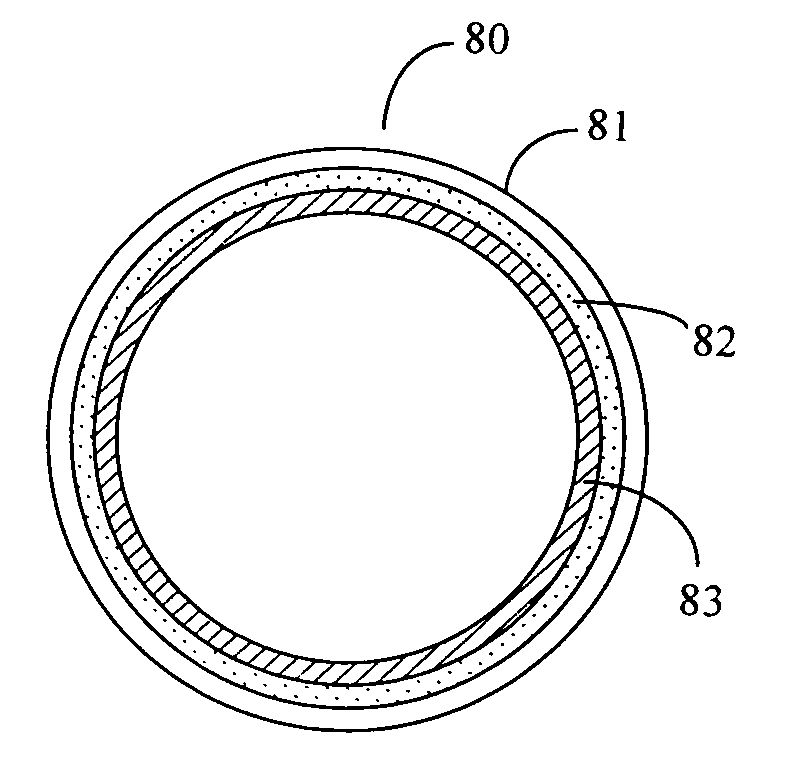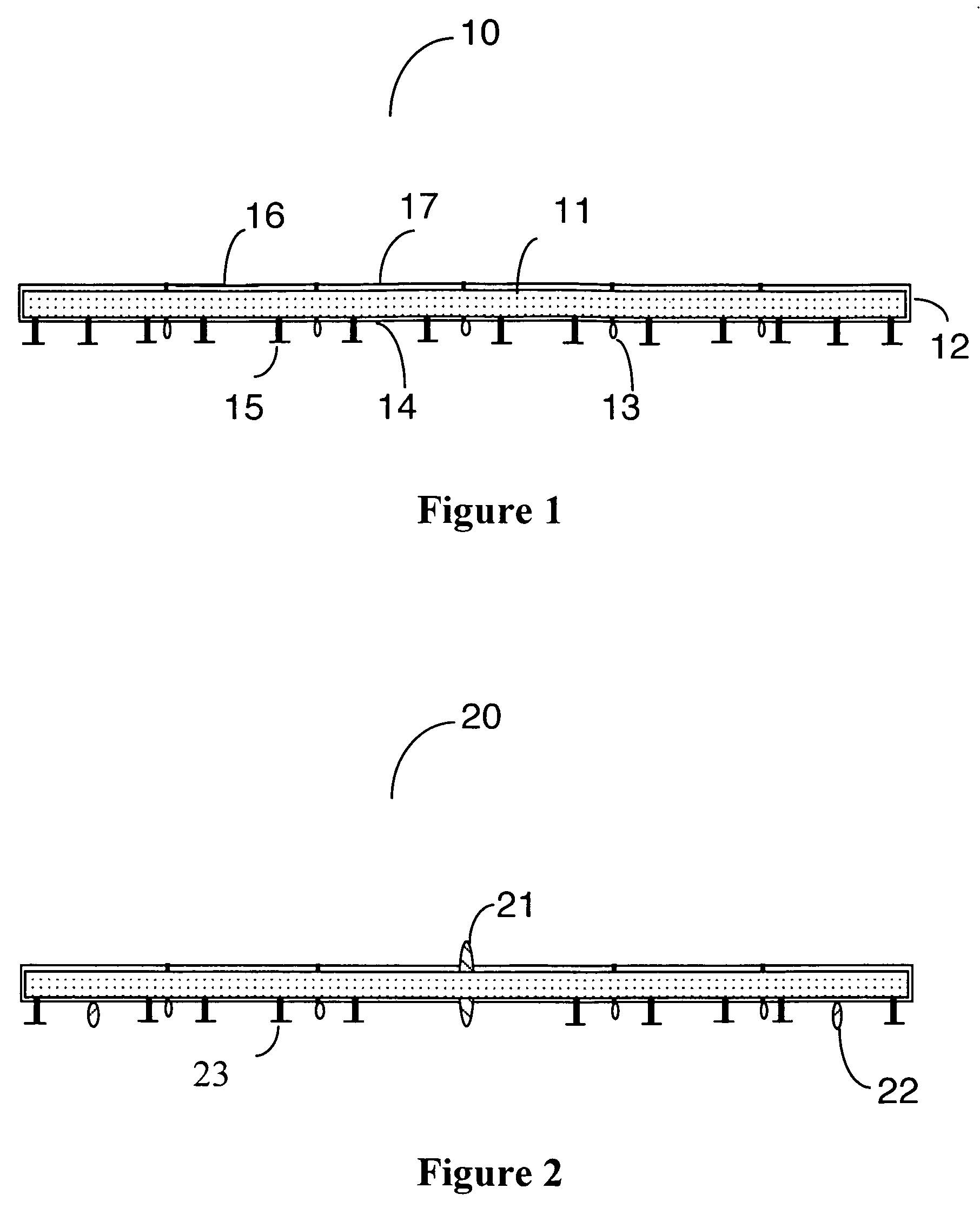[0024]The present invention captures static charge that forms on the external surfaces of an aircraft due to collisions of the aircraft with particles that exist in the earth's
atmosphere; particles that exist particularly at the altitudes that continuous duration day / night cycle solar powered aircraft are expected to fly; near 50,000 feet (15.2 km). This is a source of electrical power that has been overlooked up to the present time in the design of such day / night cycle solar powered aircraft and is shown in the present invention to be easy to capture through minor design changes in such an aircraft. The amount of electrical power produced by the present invention represents a valuable fraction of that provided by the solar powered aircraft's primary electrical
system since the present invention provides the electrical power in a continuous
stream both day and night with only a small incremental weight addition to the aircraft. Capture of this presently unused source of energy reduces the number of incremental improvements that need to be made in other primary systems of the solar powered aircraft before the goal of continuous day / night
flight duration is achieved. The method of
electric energy production discussed herein for a day / night solar powered aircraft is also
usable for the same purpose on any aircraft, airship or lighter-than-air vehicle flying in the earth's atmosphere or in the atmosphere of the
planet Mars.
[0032]To facilitate the collection of static charge on the solar cells, the present invention modifies the construction of the standard
solar cell, usually a
silicon cell coated with a
silicon oxide outer
passivation layer, by adding a thin, additional
coating to the external surface of the
standard cell to increase the electrical
conductivity of the
cell's surface. With a new
thin layer of material with higher electrical
conductivity as the
cell's outer surface, the
static charges migrate to the existing
metal electrodes of the array and thence are carried to a static charge storage device. In the present invention, the new, thin exterior
coating that is added is a
coating, for example, of higher electrical
conductivity polycrystalline-
silicon hereafter referred to as polysilicon or its equivalent added on top of the
silicon oxide layer. The new layer does not effect the operation of the solar cells in the
daytime but provides the higher electrical conductivity needed for external surface static charge migration.
[0035]For instance if the wing structure of the continuous duration solar powered aircraft is of a design like that of Helios and employs a large, hollow carbon filament tube running from wing tip to wing tip as a major structural entity, the present invention, recognizing that the carbon
fiber tube is an
electrical conductor, transforms the carbon
fiber tube into a cylindrical
capacitor using the carbon
fiber tube as one of the electrodes of the
capacitor. The second
electrode of the cylindrical
capacitor is then added in the present invention, for example, by inserting a metallic or carbon fiber
electrical conductor in the center of the first carbon fiber tube or by overwrapping the first carbon tube with an electrically insulating wrap followed by a second metallic wrap or carbon fiber wrap to form the second
electrode. One large capacitor is created if the electrodes run the full length of the tube from wing tip to wing tip or several shorter capacitors are created if the length of the tube is divided up into shorter capacitor lengths; one capacitor length per wing panel for the six panels of a Helios type aircraft. The use of several shorter capacitors provides a flexibility for storing the static charge at different maximum voltages.
[0037]For lower
voltage static charge storage, the present invention includes placing
low voltage capacitor
energy storage devices in the wing's free volume between wing ribs or between the ends of the six wing panels if the wing is constructed like that of the Helios aircraft. This is easier to implement if single sided solar cells are utilized rather than bifacial ones for the storage capacitor must not interfere with the solar
radiation incident on the backside of the bifacial solar cells. Static charge storage is accomplished in the present invention for single sided solar cells where the
solar energy incident on their backsides may be blocked without detriment by stretching two or more physically separated and horizontally arranged metalized thin sheets within the hollow wing between wing ribs or ends of a wing module to form each
face sheet of a capacitor. Metalized
Kevlar cloth or its equivalent is a possible material to be used for the flat sheets with
Kevlar's inherent strength used to support the attractive loads generated by the oppositely charged capacitor faces. For bifacial solar cells, fixed metalized sheets are placed in vertical or near vertical locations in the free volume so that solar
radiation remains incident on the backside of the bifacial cells. In another configuration of the present invention, the vertical metalized sheets are rotated about their upper ends to avoid any shadowing of the solar cells while also maximizing the amount of incident
solar energy falling on the backside of the bifacial solar cells. If the aircraft employs I-beams as structural members, the I-beams are converted into
energy storage capacitors by placing facing electrodes on the top and bottom webs of the
I beam.
[0039]It is a further objective of the present invention to incorporate design changes in the solar powered aircraft, such as the use of
dielectric materials that readily produce static charge, that facilitate the production of static charge on the aircraft.
[0046]It is a further objective of the present invention that enhanced mobility of the static charge formed on the
solar cell array on the
upper wing surface be achieved in order to carry the charge to the surrounding solar cell metallic electrodes by coating the solar cell array's outer surface with an electrical conducting material such as polysilicon or its equivalent to foster charge migration.
 Login to View More
Login to View More  Login to View More
Login to View More 


